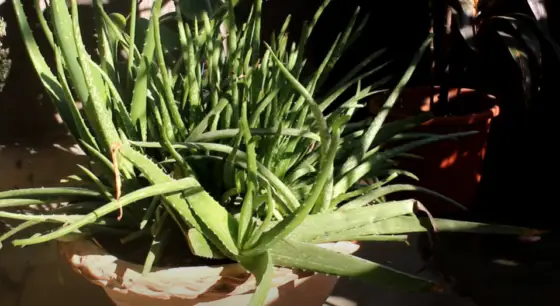Looking to add some greenery to your home or office? Aloe plants are a popular choice for many plant enthusiasts. But before you bring home one of these versatile succulents, you might be wondering, “Do aloe plants like direct sunlight?”
The short answer is yes, but it’s not quite that simple. Aloe plants do enjoy some direct sunlight, but they also need some shade to thrive. Finding the right balance is key to keeping your aloe plant happy and healthy.
So, let’s dive into the world of aloe plants and explore their relationship with sunlight.
Do Aloe Plants Like Direct Sunlight?
Aloe plants are known for their unique beauty and various health benefits. They are popular houseplants and can also be found in gardens across the world. But one important question arises when it comes to caring for aloes: do they like direct sunlight?
In this article, we will explore the relationship between aloe plants and direct sunlight, and provide you with all the information you need to keep your aloe plant healthy and thriving.
The Sun-loving Nature of Aloe Plants
Aloe plants are native to arid regions, such as the Arabian Peninsula and parts of Africa. In their natural habitat, they typically grow in sunny, dry climates with minimal shade.
This natural adaptation to sunlight makes them well-suited for bright environments. Aloe plants have thick, fleshy leaves that store water, allowing them to survive in harsh conditions.
Benefits of Direct Sunlight for Aloe Plants
While aloe plants can tolerate some shade, they generally thrive when exposed to direct sunlight. Here are some benefits of providing your aloe plant with ample sunlight:
- Increased growth:
Sunlight is a vital source of energy for plants, and aloe plants are no exception. When exposed to direct sunlight, aloes can grow faster and develop a more vibrant appearance.
- Intensified color:
Sunlight enhances the coloration of aloe plants, making their leaves appear more vibrant and attractive. The sun’s rays stimulate the production of pigments that give aloes their characteristic green hues.
- Sturdier structure:
Sunlight helps promote stronger stems and leaves in aloe plants. The direct exposure to sunlight encourages the plant to grow in an upright manner, preventing it from becoming lanky or weak.
- Enhanced healing properties:
Aloe plants are renowned for their healing properties, particularly in the gel found within their leaves. Exposure to direct sunlight can boost the concentration of beneficial compounds in the aloe gel, making it even more potent.
Read More: What Bugs To Put In Terrarium?
Optimal Sunlight Conditions for Aloe Plants
While aloe plants do well in direct sunlight, it is important to provide them with the right amount and intensity of light.
Here are some guidelines to ensure your aloe plant receives the optimal sunlight conditions:
- Duration of sunlight:
Aloe plants should ideally receive six to eight hours of sunlight each day. However, they can tolerate slightly less or more depending on their specific needs.
If you live in a region with extremely hot and intense sunlight, it may be beneficial to provide some shade during the hottest part of the day.
- Morning or afternoon sunlight:
Aloe plants prefer morning or afternoon sunlight rather than direct midday sun. This is because the intense heat during midday can sometimes be too intense for their delicate leaves, leading to sunburn or damage.
- Indoor placement:
If you are growing your aloe plant indoors, placing it near a south-facing window can provide adequate sunlight. Alternatively, you can use artificial grow lights to supplement natural sunlight.
- Outdoor positioning:
When growing aloe plants outdoors, choose a spot that receives partial to full sunlight. Avoid areas with excessive shade, as this can lead to poor growth and leggy plants.
Signs of Sunlight-related Issues
While aloe plants generally enjoy direct sunlight, it is important to monitor them for any signs of sunlight-related issues. Here are some symptoms to watch out for:
- Sunburn:
Aloe plants can get sunburned if exposed to intense sunlight for extended periods. Sunburned aloe plants may display discolored or brown patches on their leaves.
If you notice sunburn, move the plant to a shadier location and gradually reintroduce it to direct sunlight.
- Leaf discoloration:
If your aloe plant receives too little sunlight, its leaves may turn pale or yellowish. Adjust the plant’s positioning to ensure it receives the necessary amount of sunlight.
- Leggy growth:
Insufficient sunlight can cause aloe plants to stretch or become leggy as they grow. If you notice your plant leaning towards the light source or its leaves spacing out, it may be an indication that it needs more light.
- Lack of flowering:
Aloe plants require ample sunlight to bloom. If your aloe is not flowering, inadequate sunlight might be the cause. Ensure the plant receives sufficient light to encourage blooming.
Protecting Aloe Plants from Excessive Sunlight
While aloe plants thrive in direct sunlight, certain precautions can help protect them from excessive heat or intense sunlight. Here are some tips to shield your aloe plant from potential harm:
- Use shade cloth:
In regions with extremely hot climates, consider using shade cloth to filter the intensity of direct sunlight. This can help protect your aloe plant from sunburn and excessive heat.
- Move indoors during extreme temperatures:
If you experience extreme temperatures or heat waves, it is advisable to temporarily move your aloe plant indoors or provide additional shade to prevent any damage.
- Gradual exposure to sunlight:
If you are introducing a new aloe plant to direct sunlight, it is best to acclimate it gradually. Start by placing it in a partially shaded spot and gradually increase its exposure to sunlight over a period of several weeks.
- Monitor temperature and humidity:
Keep an eye on the surrounding temperature and humidity levels, as these factors can affect how your aloe plant responds to sunlight. Avoid placing your plant near drafts or excessively dry environments.
Aloe plants generally thrive in direct sunlight and benefit from its many advantages. Adequate sunlight exposure promotes healthy growth, intensifies coloration, strengthens the plant’s structure, and enhances its healing properties.
While it’s essential to provide optimal sunlight conditions, such as the right duration and intensity, it’s equally important to protect aloe plants from excessive heat or intense sunlight.
By following the guidelines outlined in this article, you can ensure your aloe plant receives the perfect balance of sunlight for optimal health and beauty.
Read More: Are Succulents Good For Terrariums?
Frequently Asked Questions (FAQs)
Aloe plants generally prefer bright, indirect sunlight. While they can tolerate some direct sunlight, too much exposure may result in sunburn and damage to the leaves.
If an aloe plant is placed in direct sunlight for extended periods, it may develop brown or white spots on its leaves, indicating sunburn. The plant may also become dehydrated and show signs of stress.
Aloe plants thrive in bright, indirect sunlight for about 6 to 8 hours per day. It is best to provide them with morning or late afternoon sun, rather than intense midday sun.
While aloe plants can withstand some direct sunlight outdoors, it is generally recommended to provide them with partial shade during the hottest parts of the day to avoid sunburn and dehydration.
If you have a south-facing window, it is advisable to position your aloe plant a few feet away from the window to protect it from the intense midday sun. Providing a sheer curtain or blinds can also help diffuse the sunlight.
Signs that an aloe plant may be receiving too much direct sunlight include leaf discoloration, dryness or wilting, and an overall unhealthy appearance. It is essential to observe the plant closely and adjust its sun exposure accordingly.
Aloe plants can thrive indoors near a sunny window, as long as the sunlight is bright but indirect. If the window receives intense midday sun, it is advisable to provide some shade or move the plant slightly away from the window.
To protect your aloe plant from excessive sunlight, you can use sheer curtains, blinds, or window films to filter the amount of direct sunlight reaching the plant. Moving the plant to a slightly shaded area or providing a light shade cloth can also be beneficial.
Final Thoughts
Aloe plants thrive in direct sunlight, making it an ideal growing condition for them. The ample sunlight provides the energy the plants need to carry out photosynthesis efficiently, promoting healthy growth. However, it is essential to strike a balance when exposing them to direct sunlight. While they require sunlight for optimal growth, excessive exposure can lead to sunburn and damage the leaves.
Therefore, it is crucial to monitor their light exposure and provide shade or move them indoors during intense afternoon sun. Overall, proper care and cautiousness in providing direct sunlight ensure that aloe plants flourish.
Auto Amazon Links: No products found.
Perfect Plants Christmas Tree Saver 8oz. | Easy Use Xmas Tree Preserver Food | Have Healthy Green Christmas Trees All Holiday Season
$9.97 (as of December 3, 2025 00:36 GMT +00:00 - More info- Product prices and availability are accurate as of the date/time indicated and are subject to change. Any price and availability information displayed on [relevant Amazon Site(s), as applicable] at the time of purchase will apply to the purchase of this product.
Kaiedos Christmas Tree Watering Funnel - 39 Inch Funnel, Reusable Design, Makes Watering Your Live Tree a Snap!
$14.99 (as of December 3, 2025 00:36 GMT +00:00 - More info- Product prices and availability are accurate as of the date/time indicated and are subject to change. Any price and availability information displayed on [relevant Amazon Site(s), as applicable] at the time of purchase will apply to the purchase of this product.
Christmas Tree Watering Funnel, Real Christmas Tree Water Long Funnel About 40 Inch, Trees Watering System for Water Indoor Outdoor
$15.99 (as of December 3, 2025 00:36 GMT +00:00 - More info- Product prices and availability are accurate as of the date/time indicated and are subject to change. Any price and availability information displayed on [relevant Amazon Site(s), as applicable] at the time of purchase will apply to the purchase of this product.
IPOOLTENG Christmas Tree Watering Funnel 3 Tube 1 Funnels 40 Inch - 3 Section Plastic Christmas Tree Funnel Waterer, Long Funnels for Watering Trees, Best Gifts for Your Parents to Water Tree
$15.53 (as of December 3, 2025 00:36 GMT +00:00 - More info- Product prices and availability are accurate as of the date/time indicated and are subject to change. Any price and availability information displayed on [relevant Amazon Site(s), as applicable] at the time of purchase will apply to the purchase of this product.
1 Pack Christmas Tree Watering Funnel System, 44 Inch Christmas Tree Watering Stick with Adjustable 3-Section Design, Reusable & Spill-Free, Xmas Plant Waterer Tool for Indoor and Outdoor
$16.99 (as of December 3, 2025 00:36 GMT +00:00 - More info- Product prices and availability are accurate as of the date/time indicated and are subject to change. Any price and availability information displayed on [relevant Amazon Site(s), as applicable] at the time of purchase will apply to the purchase of this product.
Cuisinart 6.5" Cast Iron Smashed Burger Press, Round Flat Edge Grill Press for Crispy Smash Burgers, Burger Tool for Grill and Griddle Accessories, for BBQs and Tailgates
$9.99 (as of November 30, 2025 15:21 GMT +00:00 - More info- Product prices and availability are accurate as of the date/time indicated and are subject to change. Any price and availability information displayed on [relevant Amazon Site(s), as applicable] at the time of purchase will apply to the purchase of this product.
Muddy Mat® Shown on TV Super Absorbent Microfiber Dog Door Mat for Muddy Paws, Non-Slip Washable Pet Rug, Quick Dry Chenille Entryway Carpet, Machine Washable Indoor Outdoor mat, Grey 30"x19"
$18.78 (as of November 30, 2025 15:21 GMT +00:00 - More info- Product prices and availability are accurate as of the date/time indicated and are subject to change. Any price and availability information displayed on [relevant Amazon Site(s), as applicable] at the time of purchase will apply to the purchase of this product.
Zevo Flying Insect Trap Official Refill Cartridges - Fits Both Zevo Trap & MAX Indoor Fly Trap - Authentic Trap+Lock Technology to Catch Gnats, House & Fruit Flys (4 Official Refill Cartridges)
$14.97 (as of November 30, 2025 15:21 GMT +00:00 - More info- Product prices and availability are accurate as of the date/time indicated and are subject to change. Any price and availability information displayed on [relevant Amazon Site(s), as applicable] at the time of purchase will apply to the purchase of this product.
ThermoPro TP16 Large LCD Digital Cooking Food Meat Thermometer for Smoker Oven Kitchen BBQ Grill Thermometer Clock Timer with Stainless Steel Temperature Probe
$17.99 (as of November 30, 2025 15:21 GMT +00:00 - More info- Product prices and availability are accurate as of the date/time indicated and are subject to change. Any price and availability information displayed on [relevant Amazon Site(s), as applicable] at the time of purchase will apply to the purchase of this product.
TERRO Ant Killer Bait Stations T300B - Liquid Bait to Eliminate Ants - Bait System - 12 Count Stations for Effective Indoor Ant Control
$10.86 (as of November 30, 2025 15:21 GMT +00:00 - More info- Product prices and availability are accurate as of the date/time indicated and are subject to change. Any price and availability information displayed on [relevant Amazon Site(s), as applicable] at the time of purchase will apply to the purchase of this product.











